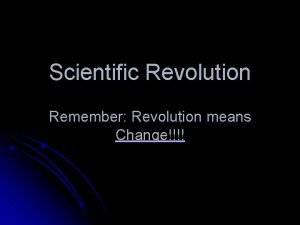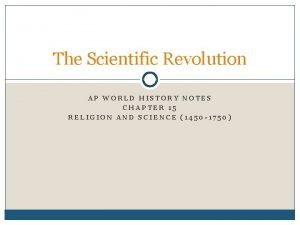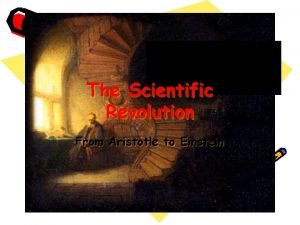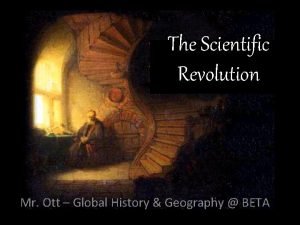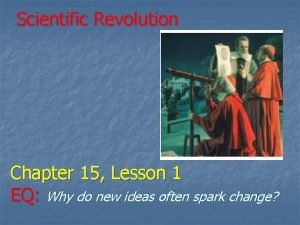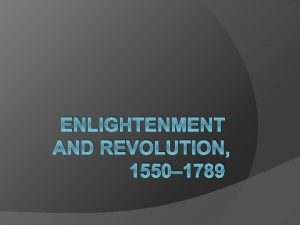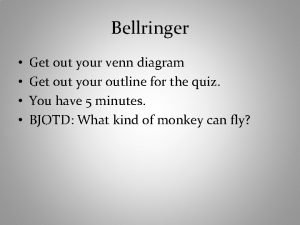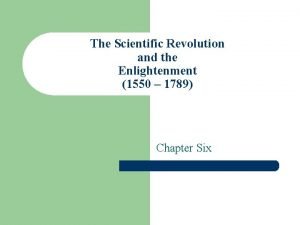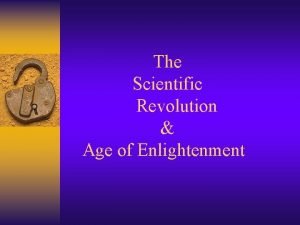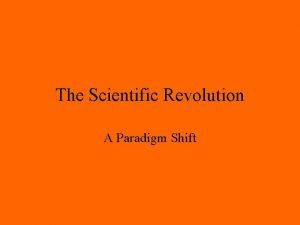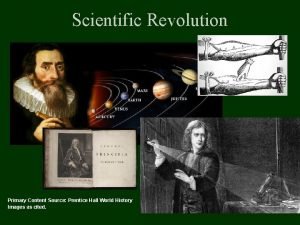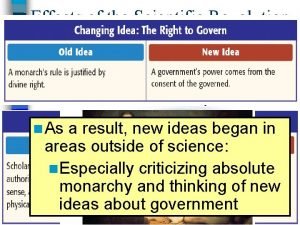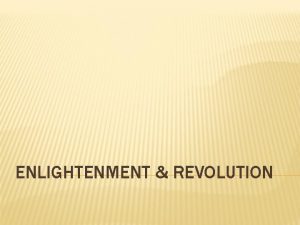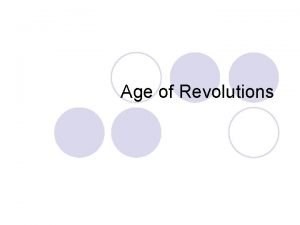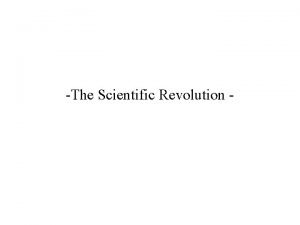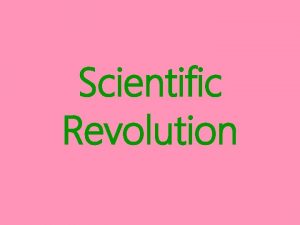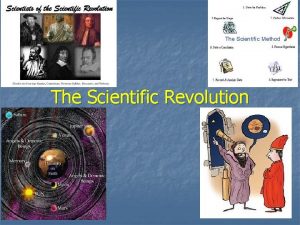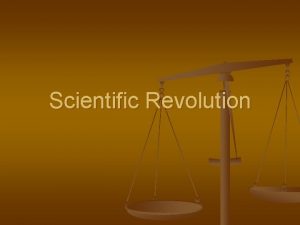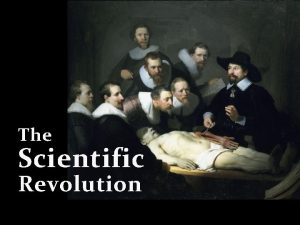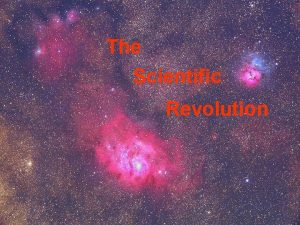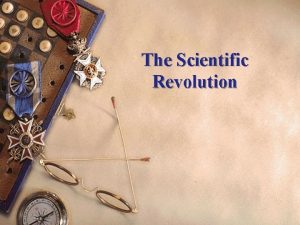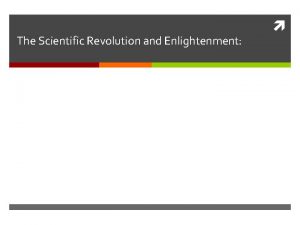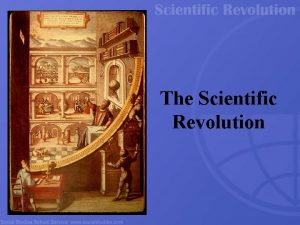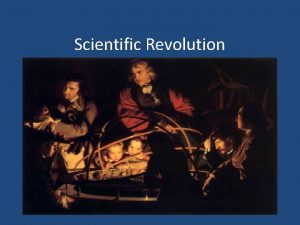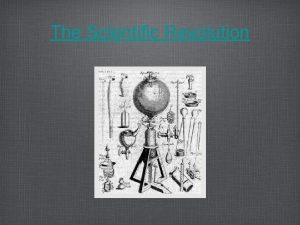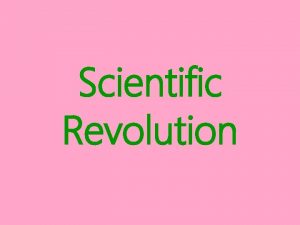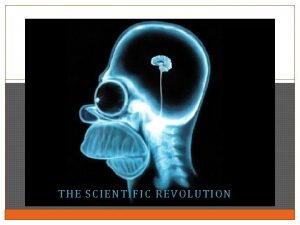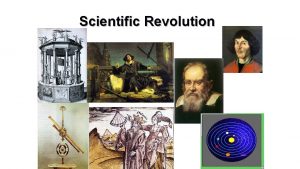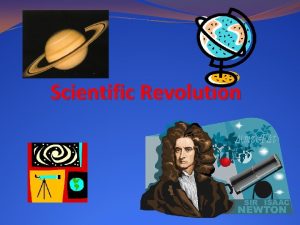The Scientific Revolution What is a Revolution A






























- Slides: 30

The Scientific Revolution

What is a Revolution? • A Revolution is a complete change, or an overthrow of a government, a social system, etc.

Recap: Europe before the Enlightenment • Absolutism dominated politics • Feudalism – dominated social realtions • Religion Justified the Staus Quo – Catholic church’s interpretation of Aristotle Everything and Everyone was in its Natural place because God designed it that way.

Feudalism • Political and social system based on the granting of land in exchange for loyalty, military assistance, and other services • Feudal Politics - The power pyramid. • Feudal Economics – The manor system • Feudal Society – Social structure and relations The Church is involved in all 3

But Challenges to this world had started • The Renaissance • The Reformation

What was the Renaissance? • Starts in Italy and spread mainly to urban areas and major trading centres • Furthering of the arts and the advancement of new techniques and styles e. g. the invention of printing in Europe and the rise of literature • Humanism - stressed the need for individuals to reach their potential in this world. • Moved away from life in the church • Focuses more on material objects and enjoying life • Greatest immediate impact of the Renaissance was the Reformation, which began in 1517

Reformation • Charges of greed and Corruption – The controversy over the sale of indulgences • Church’s great political power and wealth caused conflict • Growing human confidence vs. “original sin” – Printing press (1452) spreads Bible & scholarship

Counter-Reformation • Society of Jesus – The Jesuits – was founded in 1540 by Ignatius of Loyola, a Basque noble & soldier, to spread Catholic doctrine around the world • Catholic Church mounted reforms to reassert its authority (Reforms agreed to at the Council of Trent) • The Inquisition was established to reinforce Catholic doctrine against heresy (going against beliefs (example worshiping false gods) or challenging Church authority– used to convert, kill or place in ghettoes, all heretics (Protestants, Jews & Muslims)

The Process • An inquisitor would arrive in a village and ask all those who want to confess to heresy and ask forgiveness to do so within a month – If a person confessed to heresy within the month they would be given a light punishment. – If a person did not confess and were still found guilty: 1)they would go to trial 2)Name their enemies 3)Tortured until confession 4)Murdered if found guilty (most accused were)

Results of the Reformation • Christian Church was splintered in • • • the West - 100 Years of Religious Warfare Right of Rebellion introduced by both Jesuits and Calvinists Pope’s power increased Furthered societal individualism and secularism & Growing doubt and religious skepticism Calvinism boosted the commercial revolution (Protestant work ethic) Witch craze swept Europe in the 1600’s

The Scientific Revolution • In the 1500 s and 1600 s the Scientific Revolution changed the way Europeans looked at the world. • People began to make conclusions based on experimentation and observation, instead of merely accepting traditional ideas.

Before the Scientific Revolution… Ptolemy (87 -140 A. D. ) • Until the mid 1500’s, European scholars accepted and believed the teachings of Ptolemy, an ancient Greek astronomer. • Ptolemy taught that the Earth was the center of the universe. • People felt this was common sense, and the geocentric theory was supported by the Church. • It was not until some startling discoveries caused Europeans to change the way they viewed the physical world.

Before the Scientific Revolution… Ptolemy (87 -100 A. D. ) Ptolemy’s geocentric model of the solar system: 1. 2. 3. 4. 5. 6. 7. 8. Earth Moon Mercury Venus Sun Mars Jupiter Saturn • Notice, the Earth is first, and not the sun, as it should be.

Nicolaus Copernicus • Copernicus was a Polish astronomer who studied in Italy. • In 1543 Copernicus published On the Revolutions of the Heavenly Spheres. • In his book, Copernicus made two conclusions: 1. The universe is heliocentric, or sun-centered. 2. The Earth is merely one of several planets revolving around the sun.

Nicolaus Copernicus’ model of the solar system: 1. 2. 3. 4. 5. 6. 7. 8. Sun Moon Mercury Venus Earth Mars Jupiter Saturn • Notice, the sun is first, not the Earth, as Ptolemy believed.

Nicolaus Copernicus • Copernicus came to these conclusions using mathematical formulas. • The Copernican conception of the universe marked the start of modern science and astronomy.

Reaction to Copernicus • Most scholars rejected his theory because it went against Ptolemy, the Church, and because it called for the Earth to rotate on its axis. • Many scientists of the time also felt that if Ptolemy’s reasoning about the planets was wrong, then the whole system of human knowledge could be wrong.

Tycho Brahe • Then, in the late 1500 s, the Danish astronomer Tycho Brahe provided evidence that supported Copernicus’ heliocentric theory. • Brahe set up an astronomical observatory. • Every night for years he carefully observed the sky, accumulating data about the movement of the stars and planets.

Johannes Kepler • After Brahe’s death, his assistant, the German astronomer and mathematician Johannes Kepler, used Brahe’s data to calculate the orbits of the planets revolving around the sun. • Kepler’s calculations supported Copernicus’ heliocentric theory. • His calculations also showed that the planets moved in oval shaped orbits, and not perfect circles, as Ptolemy and Copernicus believed. Why not perfect circles…. ? • Kepler’s finding help explain the paths followed by man-made satellites today.

Galileo Galilei • Galileo Galilei was an Italian astronomer who built upon the scientific foundations laid by Copernicus and Kepler. • Galileo assembled the first telescope which allowed him to see mountains on the moon and fiery spots on the sun. • He also observed four moons rotating around Jupiter – exactly the way Copernicus said the Earth rotated around the sun.

Galileo Galilei • Galileo’s discoveries caused an uproar. Other scholars came against him because like Copernicus, Galileo was contradicting Ptolemy. • The Church came against Galileo because it claimed that the Earth was fixed and unmoving. • When threatened with death before the Inquisition in 1633, Galileo recanted his beliefs, even though he knew the Earth moved. • Galileo was put under house arrest, and was not allowed to publish his ideas. He was eventually pardoned by the Catholic Church … in 1998!

The Scientific Method • By the early 1600 s, a new approach to science had emerged, known as the Scientific Method – painstaking method used to confirm findings and to prove or disprove a hypothesis. • Scientists observed nature, made hypotheses, or educated guesses, and then tested these hypotheses through experiments. • Unlike earlier approaches, the scientific method did not rely on the classical thinkers or the Church, but depended upon a step-by-step process of observation and experimentation.

The Scientific Method 1. 2. 3. 4. 5. 6. 7. State the problem Collect information Form a hypothesis Test the hypothesis Record & analyze data State a conclusion Repeat steps 1 – 6 • Scientists soon discovered that the movements of bodies in nature closely followed what could be predicted by mathematics. • The scientific method set Europe on the road to rapid technological progress.

The Scientific Method Newton • Sir Isaac Newton was an English scholar who built upon the work of Copernicus and Galileo. • Newton was the most influential scientist of the Scientific Revolution. • He used maths to prove the existence of gravity - a force that kept planets in their orbits around the sun, and also caused objects to fall towards the earth.

The Scientific Method Newton • Newton published his scientific ideas in his book Mathematical Principles of Natural Philosophy. • He discovered laws of light and color, and formulated the laws of motion: 1. A body at rest stays at rest 2. Acceleration is caused by force 3. For every action there is an equal opposite reaction • He invented calculus: a method of mathematical analysis.

The Scientific Method According to a popular story, Newton saw an apple fall from a tree, and wondered if the force that pulled the apple to the Earth also controlled the movement of the planets. Newton argued that nature followed laws.

The Scientific Method • Francis Bacon was an English philosopher who wrote Advancement of Learning. • Bacon popularized the scientific method and used it with philosophy and knowledge. • Bacon argued that truth could not be known at the beginning of a question, but only at the end after a long process of investigation. Francis Bacon

The Scientific Method René Descartes • Descartes was a French scientist, mathematician, and philosopher. • Descartes emphasized human reasoning as the best road to understanding. • Like Bacon, Descartes also believed that truth was only found after a long process of studying and investigation. “I think, therefore I am”

Key Concept: – The scientific revolution shattered long-held views about the universe. People thought they were sitting still but they were being hurtled through space: thought they were at the centre of the universe but were not … If Church got this wrong? What else? • This encouraged Enlightenment thinkers to question society and government: – Locke (contract between government and governed) – Montesquieu (checks and balances) – Rousseau (individual freedom and civilization corrupts) – Voltaire (freedom of thought and expression) – Their beliefs in the natural rights of man inspired the American and French Revolutions.

Key Concept… Scientific revolution New thinking encourag ed New thinking leads to revolution s in America and France
 Information gathered during an experiment
Information gathered during an experiment How is a scientific law different from a scientific theory?
How is a scientific law different from a scientific theory? Causes of scientific revolution
Causes of scientific revolution Scientific revolution ap world history
Scientific revolution ap world history Scientific revolution inventions
Scientific revolution inventions Effects of scientific revolution
Effects of scientific revolution Lesson 1 the scientific revolution answer key
Lesson 1 the scientific revolution answer key How did the reformation help spur the scientific revolution
How did the reformation help spur the scientific revolution Scientific revolution and enlightenment venn diagram
Scientific revolution and enlightenment venn diagram Enlightenment vs scientific revolution
Enlightenment vs scientific revolution Causes of scientific revolution
Causes of scientific revolution Enlightenment vs scientific revolution
Enlightenment vs scientific revolution What did isaac newton do in the scientific revolution
What did isaac newton do in the scientific revolution Johannes kepler prezi
Johannes kepler prezi How do new ideas spark change
How do new ideas spark change Scientific revolution and enlightenment speed dating
Scientific revolution and enlightenment speed dating A logical procedure for gathering and testing ideas
A logical procedure for gathering and testing ideas Effects of scientific revolution
Effects of scientific revolution Scientific revolution primary sources
Scientific revolution primary sources Effects of the scientific revolution
Effects of the scientific revolution Modern commercial agriculture
Modern commercial agriculture Russian revolution vs french revolution
Russian revolution vs french revolution Did american revolution cause french revolution
Did american revolution cause french revolution Chúa sống lại
Chúa sống lại Các châu lục và đại dương trên thế giới
Các châu lục và đại dương trên thế giới Từ ngữ thể hiện lòng nhân hậu
Từ ngữ thể hiện lòng nhân hậu Diễn thế sinh thái là
Diễn thế sinh thái là Vẽ hình chiếu vuông góc của vật thể sau
Vẽ hình chiếu vuông góc của vật thể sau Thế nào là giọng cùng tên
Thế nào là giọng cùng tên Làm thế nào để 102-1=99
Làm thế nào để 102-1=99 Tỉ lệ cơ thể trẻ em
Tỉ lệ cơ thể trẻ em


